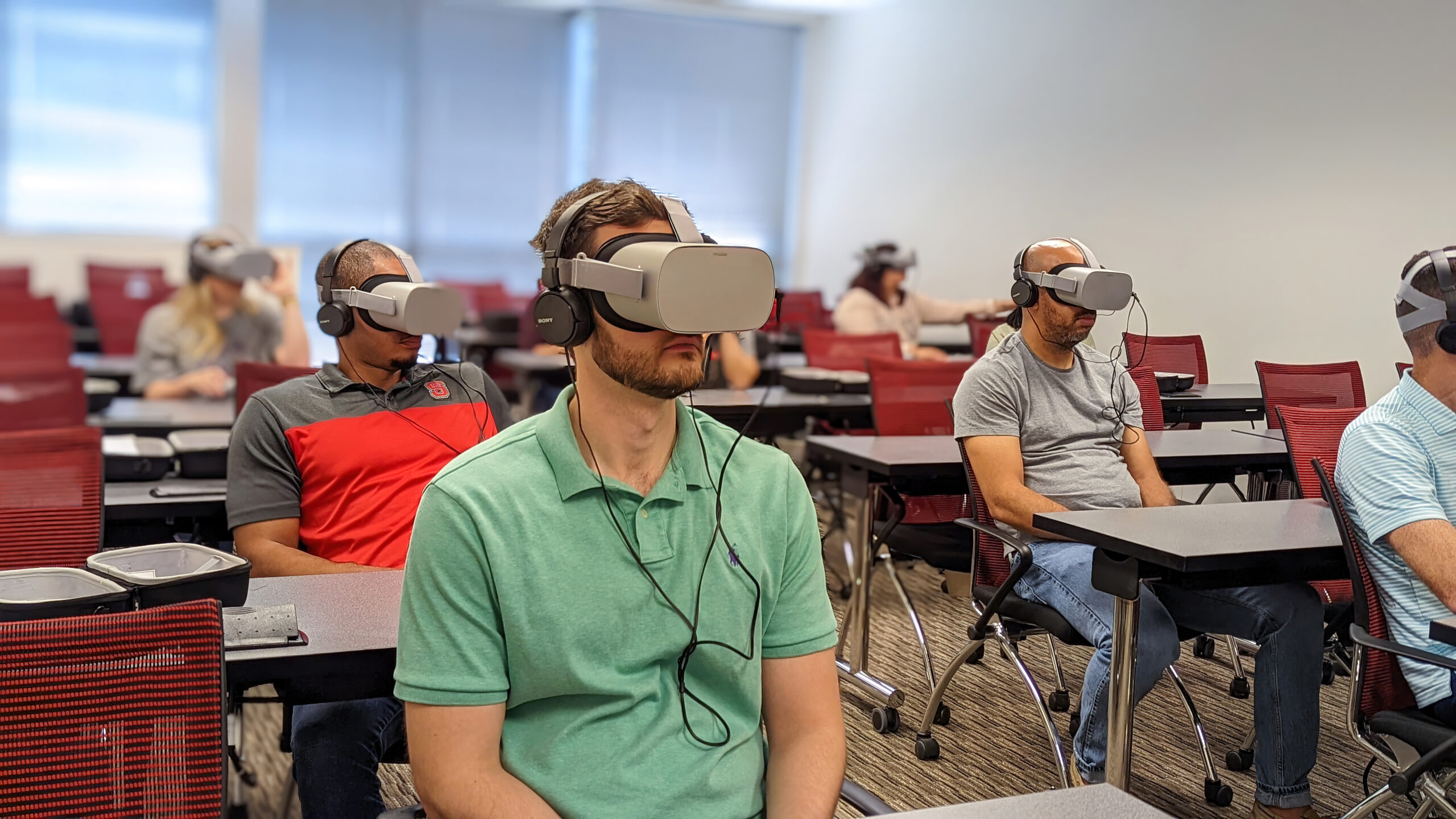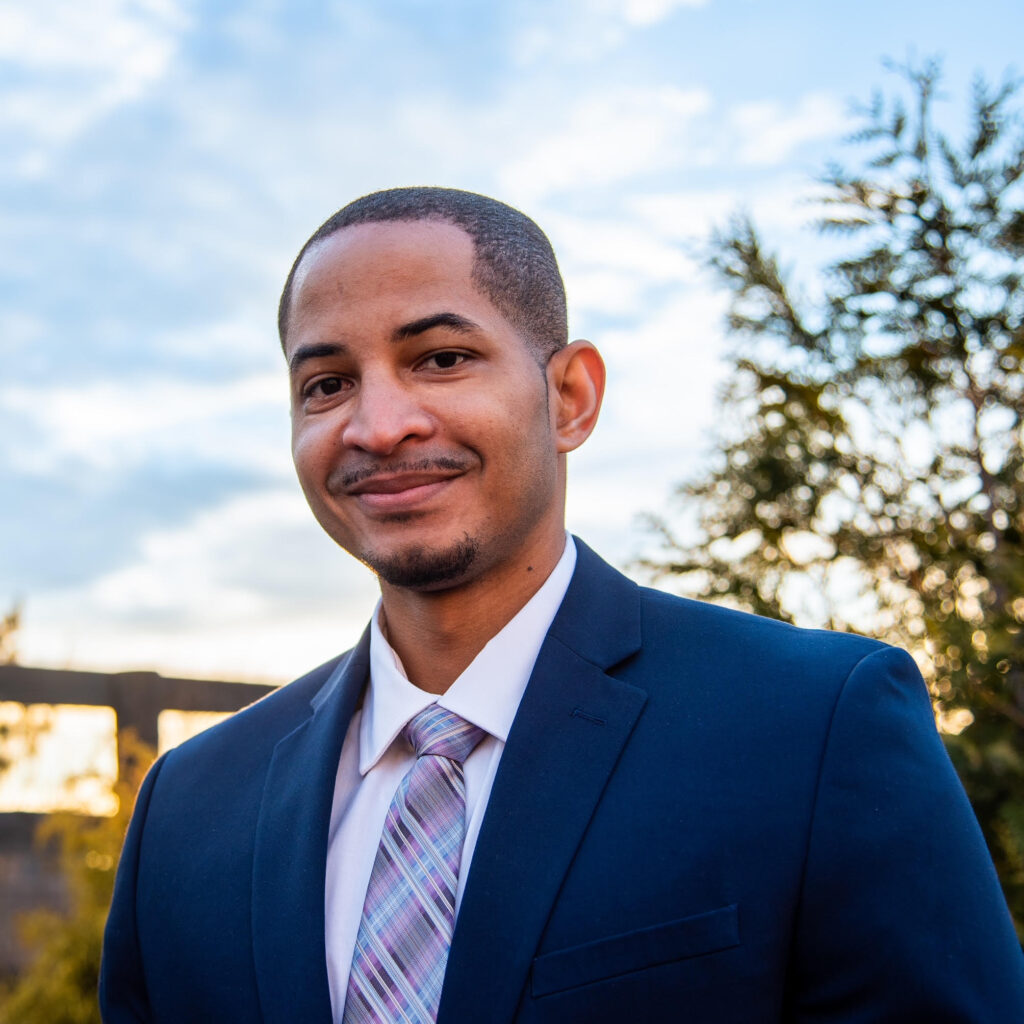Bringing Virtual Reality Into the Classroom
Virtual Reality is giving students the opportunity to bring case studies to life, making them more immersive and engaging than a traditional lecture.

By Jess Clarke
Jenkins MBA student Tovaris Holley ’22 sometimes plays a virtual reality (VR) boxing game with his 11-year-old son.
Did Holley ever expect to use a VR tool in an MBA course? “Definitely not,” he says.
But Holley and his classmates in Brad Kirkman’s MBA 535 Leading Teams course this summer did just that — and it wasn’t a game.
VR headsets transformed the classroom at NC State’s Research Triangle Park facility into a three-dimensional space where students watched a video of a meeting between a manager and an employee at a fictional entertainment company. The experience expanded on a Harvard University case study, “Gen Y in the Workforce,” about generationally diverse project teams.
“A virtual reality experience brings the case to life and makes it more immersive and engaging, and it can create a more emotional response to the materials,” Kirkman says. He’s the General (Ret.) H. Hugh Shelton Distinguished Professor of Leadership in Poole College’s Management, Innovation and Entrepreneurship Department.
The 15-minute VR experience was a pre-recorded, scripted dialogue of a meeting, performed by two actors, to represent challenges that age differences create at work. Each student watched the meeting twice, first as a third-person observer and then as someone who identified with the perspective of either the Gen Y employee, Josh, or the Gen X supervisor, Sarah.
In the second viewing, a “voice-in-the-head” feature allowed students to hear the thoughts of Sarah or Josh.
“It was definitely a different spin on learning as opposed to just sitting and listening to the professor talk,” Holley says.

“You could see certain things in practice that we had discussed in class.”
For the self-described visual learner, VR gave him an opportunity to gain insight from people’s mannerisms and other body language. “To see things in action really played into my learning style,” says Holley, an online student who works full time in sales at Honeywell International in Atlanta.
The Jenkins MBA program is in the vanguard of business schools using VR in courses. A May article in The Wall Street Journal noted increasing use of the learning tool among MBA programs, initially because the pandemic halted international travel, but VR is used for other purposes now, too.
Kirkman collaborated with NC State’s Shelton Leadership Center Director Debbie Acker on the project. They started planning before the pandemic, but Covid-19 postponed the project for about a year.
“We are always seeking ways to partner with Dr. Kirkman to leverage both units’ expertise and focus areas related to developing values-based leaders,” says Acker, who wrote the script for the VR experience.
“I felt it would be a novel and transformative way to train people in a space that allows them to feel they are physically observing the situation, which enhances the learning curve.”
Staff members with DELTA, part of NC State’s Center for Technology and Innovation, created the VR experience, which DELTA funded.
Whether or not students in Kirkman’s course had already used VR like Holley, most said after the experience in class that they empathized with the characters, which was one of Kirkman’s goals.
That includes Holley.
The VR video reinforced the importance of “being open and honest with customers and co-workers and not having pre-conceived judgments,” says Holley, who chose the Jenkins MBA program because he believes it has a higher return on investment than other programs.
He has already seen that ROI. Holley credits his MBA experience with boosting his candidacy when he applied for his current Honeywell position.
The VR experience, which Kirkman will continue to use in the MBA 535 class, could help increase students’ cultural literacy in the workplace and give them more skills that employers want. Acker wrote the script to reinforce multiple leadership concepts. Sarah is Black, and Josh is white, for example, which could generate discussions about racial diversity.
That broadens the value of the VR experience as a learning tool that sparks more class participation.
After Kirkman’s students watched the VR video, “The depth of their comments was much better because the depth of the material was better,” he says. “As more students use virtual reality for things like gaming, they get used to it. To bring it into a classroom and turn it into something more interactive will have benefits…I think it has unlimited potential really.”


